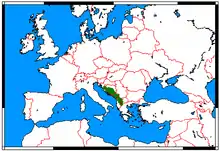Balkan snow vole
The Balkan snow vole (Dinaromys bogdanovi), also known as Martino's snow vole, is the only member of the genus Dinaromys. Eight subspecies of this vole have been recognized from southern parts of Europe. The genus name means "Dinaric mouse", referring to the Dinaric Alps. The Balkan snow vole is a living fossil, the only living species in the tribe Pliomyini, and might arguably better be placed in Pliomys, a genus established for its fossil relatives even before the Balkan snow vole was scientifically described.
| Balkan snow vole Temporal range: Early Pleistocene to Recent | |
|---|---|
| Scientific classification | |
| Domain: | Eukaryota |
| Kingdom: | Animalia |
| Phylum: | Chordata |
| Class: | Mammalia |
| Order: | Rodentia |
| Family: | Cricetidae |
| Subfamily: | Arvicolinae |
| Tribe: | Pliomyini Kretzoi, 1955 |
| Genus: | Dinaromys Kretzoi, 1955 |
| Species: | D. bogdanovi |
| Binomial name | |
| Dinaromys bogdanovi (V. et E. Martino, 1922) | |
| Subspecies | |
|
D. b. bogdanovi | |
 | |
| Balkan snow vole range | |
A 2021 study found Dinaromys (and by extension, the rest of Pliomyini) to be the sister group to the tribe Ellobiusini, from which it diverged during the late Miocene; however, this still remains uncertain.[2]
References
- Kryštufek, B. (2018). "Dinaromys bogdanovi". IUCN Red List of Threatened Species. 2018: e.T6607A97220104. doi:10.2305/IUCN.UK.2018-1.RLTS.T6607A97220104.en. Retrieved 19 November 2021.
- Abramson, Natalia I.; Bodrov, Semyon Yu; Bondareva, Olga V.; Genelt-Yanovskiy, Evgeny A.; Petrova, Tatyana V. (2021-11-19). "A mitochondrial genome phylogeny of voles and lemmings (Rodentia: Arvicolinae): Evolutionary and taxonomic implications". PLOS ONE. 16 (11): e0248198. doi:10.1371/journal.pone.0248198. ISSN 1932-6203. PMC 8604340. PMID 34797834.
- "Dinaromys". Integrated Taxonomic Information System.
- Musser, G.G.; Carleton, M.D. (2005). "Superfamily Muroidea". In Wilson, D.E.; Reeder, D.M (eds.). Mammal Species of the World: A Taxonomic and Geographic Reference (3rd ed.). Johns Hopkins University Press. pp. 894–1531. ISBN 978-0-8018-8221-0. OCLC 62265494.
